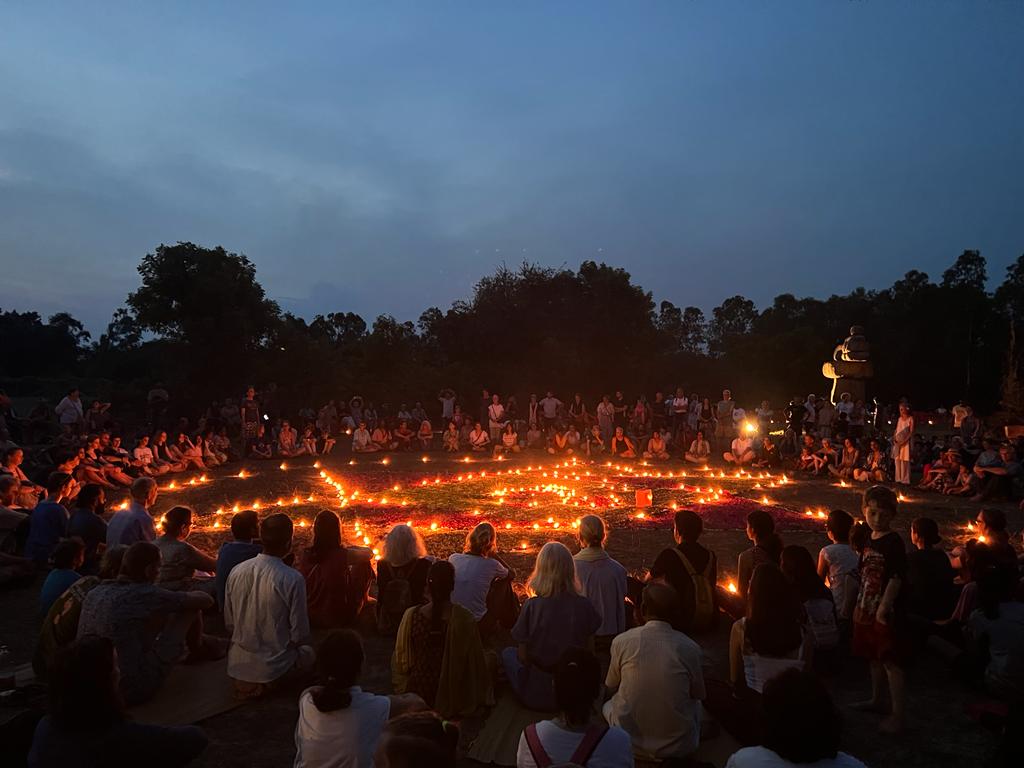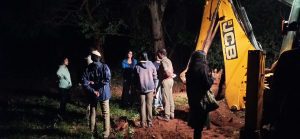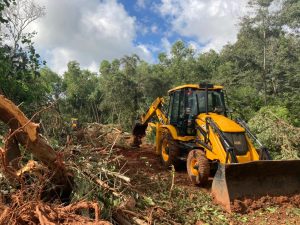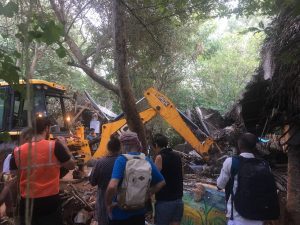The township's administration is adamant on sticking to a new Master Plan, as residents protest imposition from the top.

The main demand of the ongoing protest is more inclusivity in the implementation process of the Master Plan. (Stand for Auroville Unity)
The southern Indian township of Auroville — founded on the idea of unity in diversity — has been anything but united over the past year.
Dividing its population of 3,500, drawn from 60 nationalities including Indian, is a proposed facelift for their township.
The face of development is the 4.3 km-long Crown Road that existed in the Master Plan prepared in the mid-1960s, but did not exist on ground.
A new administration that took charge last year wants to make it real.
Many residents fear the project threatens the environment, and that their concerns are being ignored.
What riles them is the use of bulldozers, mainly to clear cherished woodlands, but once also to raze a building that served as a youth centre.
Many are appalled, though a few support the development as well.
Renu Neogy, an Auroville resident of about 40 years, is among the critics.
When the bulldozers first made their appearance on a December night last year, she joined a group of protesters to block their path.

Several locals blocked the bulldozers during the midnight felling of trees in December 2021. (Stand for Auroville Unity)
What galled her personally was having to watch from the sidelines as her daughter and other youth protesters were bundled into a police van so that they could not protest.
“This had never happened before,” Neogy told South First, recalling the incident. “People, especially the youth, were shaken. Why bring in bulldozers at midnight?”
Three days later, the youth centre and trees on a strip of what is called the “Bliss Forest” disappeared.
Tensions still simmer 10 months down the line, with the bulldozers used in yet another demolition drive as recently as last month.
Cocooned between Tamil Nadu and Puducherry, Auroville is an experimental township that has Parliament’s blessings.
Embodying the vision of spiritual reformer Sri Aurobindo, it was founded in 1958 by his spiritual collaborator Mirra Alfassa, or simply, the Mother.
French architect Roger Anger finalised the Master Plan after the Mother put her ideas on paper in 1965.
The plan has a separate residential zone for an ultimate population of 50,000 in an area of 2,000 ha.
There are three other zones — cultural, industrial, and international — and the Matrimandir, a place of spiritual significance, at its centre, ringed by a green belt.
Governing board Secretary Jayanti Ravi wants to implement an updated plan, the government-approved Master Plan (Perspective 2025), but residents fear that the loss of trees this entails will be extensive.
On 12 September this year, bulldozers once again tore through a patch of trees, this time of a tropical dry evergreen variety, that the locals lovingly called “Evergreen forest”.

Protesting Aurovillians have claimed that the development plan will destroy the township’s forest ecosystem. (Stand for Auroville Unity)
Nurtured by residents, the “forest” had survived for decades. But that day, it became the third wooded area to come under the threat of development work since December 2021, the other being Dharkali “forest”.
Protesters claim 900 trees have been felled so far, and fear the toll will be 150,000 if the plan is implemented in full.
“There are tropical dry evergreen trees in the Dharkali forest that are endangered and cannot be transplanted,” said Natasha Storey, a resident for about 20 years.
“As for replanting, they haven’t left space for that,” Storey told South First.
In fact, in order to protect the trees, two residents petitioned the National Green Tribunal (NGT), South Zone, on 29 January, seeking a halt to constructions based on the Master Plan Perspective 2025.

Most felled trees are of the tropical dry evergreen variety that cannot be transplanted. (Stand for Auroville Unity)
The petition noted “large-scale tree felling” started towards clearing the right of ways for the Crown Road and other features on the plan, without any environmental impact assessment.
Though the NGT allowed the Crown Road project to continue in conjunction with conditions, it halted the construction work related to the new Master Plan.
Residents also say a clause in the Master Plan Perspective 2025 mandating submitting development plans every five years to the residents’ assembly was flouted.
“No detailed plans have been submitted, and there have been no reviews,” said Neogy.
“We residents have not been included in this process.”
People like Neogy and Storey, who oppose Ravi, say they are not against development per se; it is the manner in which plans are being implemented that galls them.
“We have an issue with the top-down, authoritarian approach,” Storey said. “The project and the process of implementation are being imposed on us.”
She referred to the structure of Auroville Foundation, an autonomous body under the Ministry of Education that oversees the township’s affairs, to press her point.
The Foundation has three arms: The governing board; the residents’ assembly, and an international advisory council that advises the foundation on relevant issues.
“All are equal, as members of the residents’ assembly, we have an equal say,” said Storey. “There is no administrative hierarchy.”
And yet, they are being ignored, she says.
This is, perhaps, also seen in differences over environmental issues.
Storey said critics, concerned by the possible environmental impact of the development programme on water bodies and the trees in the township, had proposed an alternate plan.
“There is a stretch in Dharkali that had been marked long ago as the area for the Crown Project,” Storey said. “That is why no trees were planted there, so we suggested using that instead.”
This idea was not entertained.
Another proposal related to two check dams that would be affected by development work.
“Although man-made, these were created according to the natural slope. So we proposed bridges to go over them in the alternate plan,” Storey said.
This plan too was rejected.
“They don’t see the Master Plan as flexible,” Storey stated.
Auroville Foundation, which has sought ₹1,000 crore from the Centre for the implementing the development programme, scoffs at the various charges.
Residents themselves have approved the Master Plan, claims Auroville Foundation spokesperson Joel Van Lierde.
“The residents’ assembly had decided to implement the plan in 1999, but the community has not been able to do the work until now,” Lierde told South First.
As for Neogy’s charge that development plans were not being submitted to residents, he said the governing board interpreted the clause differently.
“Once the construction work starts, only then the plans can be reviewed every five years. How can there be reviews when it had not begun?”
As for the felled trees, he said: “For every tree that will be uprooted, 10 more will be replanted.”
However, a sceptical Storey says some trees are of a special species that cannot be replanted.
In its affidavit to the NGT, the foundation also questioned the term “forest” that residents use for woodlands in the township.
“None of the trees planted in Auroville result in any part of Auroville becoming a forest by the mere fact of such tree plantation,” it said.
“Even the trees planted in the A-C categories listed above, do not make any of these land areas into a ‘forest’ or ‘deemed forest’, it added, referring to trees planted in the green belt and outside the Master Plan area.
Agrees Anu Majumdar, living in Auroville for four decades.
“The Bliss area land was bought on donation money, and now it is occupied in the name of a forest,” she told South First.
“Trees were initially planted for timber but they have weaponised it.”

May 18, 2024

May 18, 2024

May 18, 2024

May 18, 2024

May 16, 2024

May 16, 2024